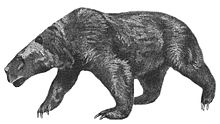Amphicynodontidae
| Amphicynodontidae | |
|---|---|

| |
| Artist's restoration of Kolponomos newportensis. | |
| Scientific classification | |
| Domain: | Eukaryota |
| Kingdom: | Animalia |
| Phylum: | Chordata |
| Class: | Mammalia |
| Order: | Carnivora |
| Infraorder: | Arctoidea |
| Subfamily: | †Amphicynodontinae Simpson, 1945 |
| Genera | |
Amphicynodontinae is a probable clade of extinct arctoids. While some researchers consider this group to be an extinct subfamily of bears,[1] a variety of morphological evidence links amphicynodontines with pinnipeds, as the group were semi-aquatic otter-like mammals.[2][3][4] In addition to the support of the pinniped–amphicynodontine clade, other morphological and some molecular analyses support bears being the closest living relatives to pinnipeds.[5][6][7][3][8][4] According to McKenna and Bell (1997) Amphicynodontinae are classified as stem-pinnipeds in the superfamily Phocoidea.[9] Fossils of these mammals have been found in Europe, North America and Asia.[4] Amphicynodontines should not be confused with Amphicyonids (bear-dogs), a separate family of Carnivora which is a sister clade to arctoids within the caniforms, but which may be listed as a clade of extinct arctoids in older publications.
Systematics
- Subfamily †Amphicynodontinae (Simpson, 1945)
- †Amphicticeps (Matthew and Granger, 1924)
- †Amphicticeps makhchinus (Wang et al., 2005)
- †Amphicticeps dorog (Wang et al., 2005)
- †Amphicticeps shackelfordi (Matthew and Granger, 1924)
- †Parictis (Scott, 1893)
- †Parictis primaevus (Scott, 1893)
- †Parictis personi (Chaffee, 1954)
- †Parictis montanus (Clark & Guensburg, 1972)
- †Parictis parvus (Clark & Beerbower, 1967)
- †Parictis gilpini (Clark & Guensburg, 1972)
- †Parictis dakotensis (Clark, 1936)
- †Kolponomos (Stirton, 1960)
- †Kolponomos newportensis (Tedford et al., 1994)
- †Kolponomos clallamensis (Stirton, 1960)
- †Allocyon (Merriam, 1930)
- †Allocyon loganensis (Merriam, 1930)
- †Pachycynodon (Schlosser, 1888)
- †Pachycynodon tedfordi (Wang & Qiu, 2003)
- †Pachycynodon tenuis (Teilhard de Chardin, 1915)
- †Pachycynodon filholi (Schlosser, 1888)
- †Pachycynodon boriei (Filhol, 1876)
- †Pachycynodon crassirostris (Schlosser, 1888)
- †Amphicynodon (Filhol, 1881)
- †Amphicynodon mongoliensis (Janovskaja, 1970)
- †Amphicynodon teilhardi (Matthew and Granger, 1924)
- †Amphicynodon typicus (Schlosser, 1888)
- †Amphicynodon chardini (Cirot and De Bonis, 1992)
- †Amphicynodon cephalogalinus (Teilhard, 1915)
- †Amphicynodon gracilis (Filhol, 1874)
- †Amphicynodon crassirostris (Filhol, 1876)
- †Amphicynodon brachyrostris (Filhol, 1876)
- †Amphicynodon leptorhynchus (Filhol, 1874)
- †Amphicynodon velaunus (Aymard, 1846)
- †Amphicticeps (Matthew and Granger, 1924)
References
- ^ McLellan, B.; Reiner, D.C. (1992). "A review of bear evolution". International Association for Bear Research and Management. 9 (1): 85–96. doi:10.2307/3872687. JSTOR 3872687.
- ^ Tedford, R. H.; Barnes, L. G.; Ray, C. E. (1994). "The early Miocene littoral ursoid carnivoran Kolponomos: Systematics and mode of life" (PDF). Proceedings of the San Diego Society of Natural History. 29: 11–32. Archived from the original (PDF) on 22 September 2012. Retrieved 24 July 2010.
- ^ a b Rybczynski, N.; Dawson, M.R.; Tedford, R.H. (2009). "A semi-aquatic Arctic mammalian carnivore from the Miocene epoch and origin of Pinnipedia". Nature. 458 (7241): 1021–24. doi:10.1038/nature07985. PMID 19396145.
- ^ a b c Berta, A.; Morgan, C.; Boessenecker, R.W. (2018). "The Origin and Evolutionary Biology of Pinnipeds: Seals, Sea Lions, and Walruses". Annual Review of Earth and Planetary Sciences. 46: 203–228. doi:10.1146/annurev-earth-082517-010009.
- ^ Hunt, R. M. Jr.; Barnes, L. G. (1994). "Basicranial evidence for ursid affinity of the oldest pinnipeds" (PDF). Proceedings of the San Diego Society of Natural History. 29: 57–67.
- ^ Lento, G. M.; Hickson, R. E.; Chambers, G. K.; Penny, D. (1995). "Use of spectral analysis to test hypotheses on the origin of pinnipeds". Molecular Biology and Evolution. 12 (1): 28–52. doi:10.1093/oxfordjournals.molbev.a040189. PMID 7877495.
- ^ Wang, X.; McKenna, M. C.; Dashzeveg, D. (2005). "Amphicticeps and Amphicynodon (Arctoidea, Carnivora) from Hsanda Gol Formation, central Mongolia and phylogeny of basal arctoids with comments on zoogeography". American Museum Novitates. 483 (3483): 216. doi:10.1206/0003-0082(2005)483[0001:AAAACF]2.0.CO;2. hdl:2246/5674.
- ^ Higdon, J. W.; Bininda-Emonds, O. R.; Beck, R. M.; Ferguson, S. H. (2007). "Phylogeny and divergence of the pinnipeds (Carnivora: Mammalia) assessed using a multigene dataset". BMC Evolutionary Biology. 7: 216. doi:10.1186/1471-2148-7-216. PMC 2245807. PMID 17996107.
{{cite journal}}: CS1 maint: unflagged free DOI (link) - ^ McKenna, M.C.; Bell, S. (1997). Classification of Mammals Above the Species Level. Columbia University Press, New York.




